Elora, Ontario 作者: 来源: 发布时间:2021-12-07
I.Population and Area
-Population (Estimated)
Total: 7,756
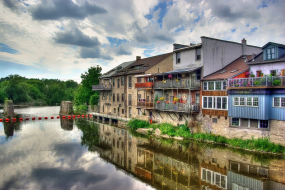
II.Natural Geography (environment and resources)
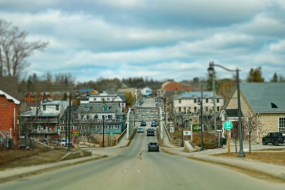
-Elora is a community in the township of Centre Wellington, Wellington County, Ontario, Canada. It is well known for its 19th-century limestone architecture and the geographically significant Elora Gorge.
-Elora is no longer an independent entity. In 1999, the Township of Centre Wellington was formed by amalgamating the Town of Fergus; the Village of Elora; and the Townships of Nichol, Pilkington, West Garafraxa, and part of Eramosa. In 2011, the community referred to as Elora had a population of approximately 7,756.
-Elora is situated on the Grand River, approximately 20 km (12 mi) north of Guelph, and 20 km (12 mi) northeast of Kitchener-Waterloo.
-Elora has a humid continental climate (Dfb) under the Köppen climate classification with cold winters and warm summers.
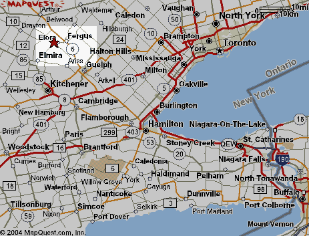
III.ECONOMY
-Example by using one common job:

-Website: https://ca.indeed.com/cmp/Elora-Mill-Hotel-&-Spa/salaries
IV.Industrial Characteristics
-Many tourists visit Elora on day trips, attracted by the historic nature of the town or the Grand River Raceway with horse racing and slot machines. It has many small shops, pubs, cafés, restaurants and art galleries. These are often in buildings built during the mid 19th century. The Gorge Cinema is Canada's oldest continuously running repertory theatre. The annual Elora Festival & Singers event is particularly popular.
-The Elora Gorge and its Conservation Area are at the edge of town. The park offers canoeing, paddleboat rentals, hiking, camp-grounds, fishing and picnicking. Some of the limestone cliffs are 80 feet high. At the eastern end of the village is the Elora Quarry Conservation Area, a scenic former limestone quarry, and is now a popular swimming area.
-Restored buildings on Water St., (shops and restaurants), line the Grand River in the downtown area.
-In 2001, a group of citizens organized an arts and cultural centre, the Elora Centre for the Arts, at the site of a century school whose headmaster had been at one time David Boyle, who was well known as an educator in the late 1800s.
-The township of Centre Wellington has an active historical society and operates the Wellington County Museum and Archives in a historic stone building in Aboyne, halfway between Elora and Fergus, Ontario. This two-storey Italianate-style stone building was the oldest known state-supported poorhouse or almshouse in Canada, called the House of Industry and Refuge when it opened in 1877. The museum opened in 1975 and the building was designated a National Historic Site of Canada in 1995.
V.Attractions
1.Elora Gorge
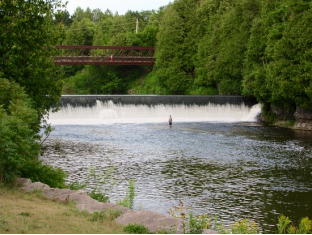
-The Elora Gorge is a popular tourist attraction located at the western edge of Elora, Ontario, Canada, which is 25 km north from the city of Guelph through highway 6.
-As the Elora Gorge Conservation Area, it is one of many conservation areas owned by the Grand River Conservation Authority.
-The Grand River flows through the bottom of the gorge, approximately 2 kilometres (1.2 mi) long, with limestone cliffs reaching 22 metres (72 ft) high. It was formed from glacial meltwaters from the previous ice age. The area includes a park with camping sites, hiking trails, and is also popular for kayaking and tubing.
-Located nearby is the "old swimming hole", at the Elora Quarry Conservation Area, a 0.8 hectare (two acre) former limestone quarry encircled by sheer cliffs up to 12 metres (39 ft) high. Elora Quarry did not become a conservation area until 1976, but it was a popular swimming area long before that.
-The Elora Gorge Falls are a roughly 25 ft (7.6 m) tall waterfall located upstream from the Elora Gorge.
-Popular activities at the site include: camping, canoeing, fishing, hiking, cycling, swimming, picnicking, and tubing.
-The Quarry served as a film location in the 2017 adaptation of Stephen King’s novel It, as well as it's 2019 sequel.
-Address: 7400 Wellington County Rd 21, Elora, ON N0B 1S0
-Phone: (519) 846-9742
-Website: https://www.grandriver.ca/en/outdoor-recreation/Elora-Gorge.aspx
2.Bissell Park
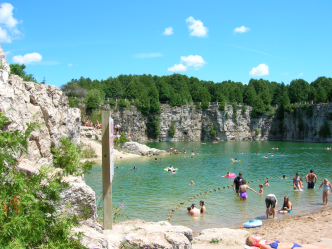
-At Bissell’s Hideaway, we are proud to offer campground and cabin rental facilities with a little something for everyone. Our sites are home to a wide range of activities including large, quiet campsites, a one-acre swimming pool, and a whole host of leisure facilities.
-Why look any further, when planning your ideal vacation destination is as simple as giving us a call? Bissell’s Hideaway is located just minutes from the region’s most awe-inspiring geographical feature, Niagara Falls.
-Address:
205 Metler Road, R.R. #1
Ridgeville, Ontario,
L0S 1M0
-Email: theoffice@bissellshideaway.com
-Toll-free: 1-888-236-0619
-Website: https://bissellshideaway.com/contact/
3.Wellington County Museum and Archives
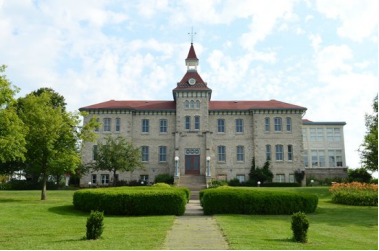
-The Wellington County Museum and Archives is a National Historic Site located in the building that stands as the oldest remaining House of Industry and Refuge in Canada.
-Built in 1877 as place for the poor, homeless, and destitute people of Wellington County, it operated as a Poor House and Industrial Farm until 1947. It then served as the County Home for the Aged until 1974, when it became the Wellington County Museum and Archives. An Archives wing was added, opening in 2010.
-Our Mandate is to serve as a cultural centre, providing resources, programmes, exhibits, support and services for the historical, educational and artistic interests of the communities of Wellington County. The Museum tells the stories of the people and places of Wellington County through professionally curated exhibits displayed in nine galleries.
-The Archives features a spacious public reading room with microfilm reader and printers, public computers, free Wi-Fi, and free access to Ancestry.ca - everything for the family historian or local history researcher!
-Phone: (519) 846-0916
-Website: https://www.wellington.ca/en/discover/mus-visit-us.aspx?_mid_=11242
VI.History
-Roman Catholic missionaries first visited the area in the early to mid 1600s, attempting to Christianize the indigenous people, particularly the Neutral Nation on the Attiwandaronk Lands. The first European settlers arrived in 1817, and Roswell Matthews built a home here the next year.
-Captain William Gilkison (1777-1833) was born in Ayrshire, Scotland, and emigrated to North America in 1796. He served with the British forces in the War of 1812 as an assistant quartermaster-general, and in 1832 purchased some 14,000 acres of land in Nichol Township. He selected this area near the falls of the Grand River as a town site for his proposed settlement and named it Elora. It was laid out by Lewis Burwell, deputy provincial land surveyor, late in 1832, and the following year Gilkison established a sawmill and a general store. The founder of Elora died in April, 1833, before the full results of his foresight and enterprise were achieved.
-Elora was founded in 1832 by Captain William Gilkison, originally from Scotland, who was a British officer recently returned from India. He had also served in the War of 1812, fighting the nascent United States. He bought 14,000 acres of land on the Grand River and settled on the east side of the river. The plan for the settlement was laid out by Lewis Burwell, in late 1832, when it was called Irvine Settlement. By 1833, Gilkison had opened a sawmill and a general store. Gilkison named the community after his brother's ship, which was itself inspired by the Ellora Caves near Aurangabad, Maharashtra, India.
-Charles Allan and Andrew Geddes laid out a town site on the west side of the river. By 1848, village lots were being sold and the settlement was incorporated into a village in 1858. The commercial area was near the grist mill, by the waterfalls (Mill St.) and eventually moved further up the hill.
-The Smith's Canadian Gazetteer of 1846 describes Elora as having a beautiful waterfalls and a deep channel carved by the river in the limestone rock. At the time there were only 100 inhabitants but two churches, three mills and a Post Office. Otherwise there were a few tradesmen and a single tavern.
-In the 1850s and 1860s, Elora was a major agricultural marketplace. Stores in the downtown area sold many types of goods. The flour mill and saw mill were powered by the Grand River. In 1869 the population was 1,500. By 1870, several other mills, two distilleries, a carpet factory, tannery and two furniture factories were operating. While there were some earlier private providers of electricity on a small scale, more extensive provision of power, by Ontario Hydropower, began in 1914.
-Elora Mill
-The extant five-storey Elora grist mill was built in 1832, and through its history housed a sawmill, distillery and flour mill. In the 1970s, it became a hotel called the Elora Mill Inn, which closed in 2010. Plans were submitted to convert the building to condominiums and a hotel, and in 2017 a report stated "Elora Mill Inn and Spa, a $120 million project expected to bring a world class resort and 250 jobs to the area when it opens in Spring 2018. Following a $27 million renovation, the Elora Mill Hotel and Spa, owned by Pearle Hospitality, opened in July 2018, employing 170 people and featuring 30 rooms and a restaurant. Construction of the condominium section of the property was to begin in 2019.
-In February 2020, the property was awarded a Heritage Recognition Award by Heritage Centre Wellington.
-David Street (Irvine Creek) bridge
-In 2002 the Township of Centre Wellington announced that, for safety reasons, it would be necessary to demolish the historically important David Street Bridge over Irvine Creek. The structure and its pier had been built in 1868 by Charles Lawrence, a stonemason. The structure was "the first cantilever bridge in North America". (A more modest earlier bridge had been built over the Irvine Creek in 1848.) It is described as one of the few remaining open-spandrel concrete arch bridges and is listed in the Ontario Heritage Bridge Program. Concerned about the preservation of Elora's culturally significant architecture, the group Elora Heritage was founded. They received over 1,000 names on a petition. They met with representatives from town council as well as the provincial and federal governments.
-It became apparent that the bridge was beyond preservation; however council agreed to preserve the pier and build a replica bridge in 2004. The project presented numerous engineering challenges but was successfully completed. The current structure is similar to the 1921 bridge; the 1867 stone pier was retained as had been planned.
-Victoria Street Bridge
-Most parts of another bridge over the river, known as the Victoria Street Pedestrian Bridge, had been demolished years ago but it was being rebuilt in 2019 as part of the downtown re-development.
-The first Victoria Street Bridge over the Grand River was built in 1843, again in 1871 and lastly the as a Pratt struss bridge in 1899. The latest structure, a non truss concrete beam pedestrian bridge with decorative railings and stone cladding mimicking arch below, replaced the previous structure which was demolished in 2006. Named for Jack R. MacDonald, the new bridge opened in November 2019 and allows for increased pedestrian access into the core.
-Metcalfe Badley Bridge
-The Metcalfe Street (Badley) Bridge (c. 1952-1953) is the main vehicular bridge with direct access into town. The Parker Through truss bridge has been assessed as in poor state and would be closed for repairs or replacement. The new bridge will not be a truss bridge in order to accommodate vehicles, cyclists and pedestrians. The scope of the Victoria St. project was described as:
-Construction of the bridge deck concrete topping and side curbs, masonry pilasters, steel framing and arched masonry stone side skirts along the bridge, steel railings, electrical, lighting and the finished piazza concrete slab, retaining wall, storm sewer extension and planting beds.
-A report in April 2020 indicated that the new bridge was expected to be completed in late 2020. Specific benefits discussed at that time included "wider traffic lanes and sidewalks, two new bike lanes, an expanded observation deck, enhanced lighting, limestone gateway piers".
-From "poorhouse" to museum
-In 1877, the County opened the Wellington County House of Industry and Refuge, or Poorhouse as it was called, on Wellington Road 18 between Fergus and Elora. Over the years, approximately 1500 "deserving" poor, including those who were destitute, old and infirm or suffering from disabilities were housed here. The sixty bed house for "inmates" was surrounded by a 30-acre "industrial" farm with a barn for livestock that produced some of the food for the 70 residents and the staff and also provided work for them. Others worked in the House itself. According to a 2009 report by the Toronto Star, "pauperism was considered a moral failing that could be erased through order and hard work". A hospital was added in 1892. A nearby cemetery has 271 plots for those who died. In 1947 the House was converted into the Wellington County Home for the Aged and in 1975 the building reopened as the Wellington County Museum and Archives.
-A historic plaque was erected at the museum, indicating that the "government-supported poorhouse" was "the shelter of last resort for the homeless and destitute, who traded spartan accommodations for domestic or agricultural labour".
VII.Other information
I.Ontario Network of Entrepreneurs– a collaborative network built to help your business succeed.
-Canada Ontario Business Service Centre – a one stop shop for information on how to start and grow businesses in Canada – tons of information from being an entrepreneur to accessing investment capital.
-Innovation Guelph - acts to cultivate entrepreneurship, powerful partnerships, and innovative initiatives that transform the way we do things in business and in our communities.
-County of Wellington - The County of Wellington is made up of seven lower tier municipalities including the Town of Erin, Town of Minto, Township of Wellington North, Township of Mapleton, Township of Centre Wellington, Township of Guelph/Eramosa and the Township of Puslinch.
-Ministry of Economic Development, Employment and Infrastructure, Province of Ontario – supports a strong, innovative economy that can provide jobs, opportunities and prosperity for all Ontarians.
-Ministry of Agriculture and Food /Ministry of Rural Affairs – supports the sectors that keep rural communities economically successful is a priority.
VIII.Contact information
-Government
Mayor: Mayor Kelly Linton
Address: 1 Macdonald Square, Elora, ON N0B 1S0
-Phone: (519) 846-9691
-Website: https://www.elora.info/services
